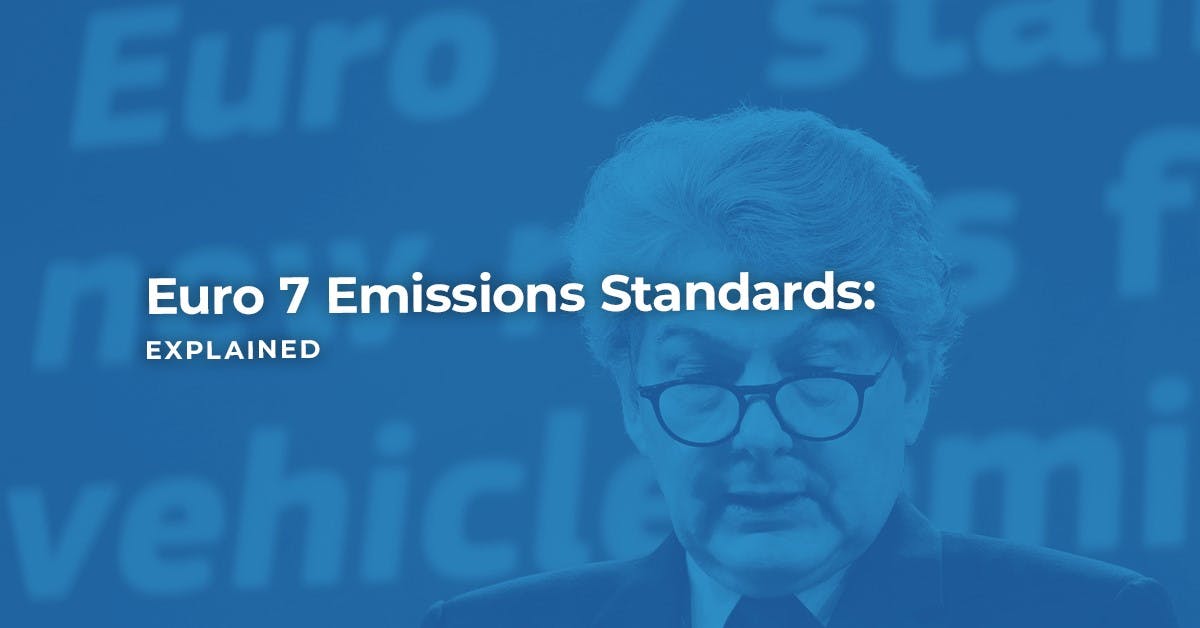The new Euro 7 rules bring emission limits for all motor vehicles which will come into effect in July 2025.
For HGVs and PSVs these rules will come into force as of July 2027.
These regulations will set a maximum standard for emissions for new cars and vehicles sold in Europe (and the UK).
New cars will not be approved for sale if they generate more pollutants than the Euro 7 standards allow.
The Euro 7 emissions standards are still to be finalised, as car manufacturers and European lawmakers are in disagreement over the level of emissions that should be permitted and how Euro 7 will come into force.
As such, certain aspects of the Euro 7 emissions standards listed below could be subject to change for the time being.
Read on and find out when exactly these standards will be introduced, and what makes Euro 7 different from Euro 6.
Page Contents
- What Are the Euro 7 Emissions Standards?
- When Will the Euro 7 Emissions Standards Be Introduced?
- What Is the Aim?
- Why Are the Euro 7 Standards Relevant to Consumers?
- What Makes Euro 7 Different to Euro 6?
- What Else Will the Euro 7 Standards Change?
- What Is the Petrol and Diesel Car Ban?
- How Will Car Emissions Be Tested for Euro 7?
- What's the Latest?
- FAQs
What Are the Euro 7 Emissions Standards?
The Euro 7 emissions standards simplify the Euro 6 framework as they are a single set of rules for any vehicle – regardless of whether it runs on petrol, diesel or alternative fuels.
Euro 7 also applies to vehicles that run on electricity or are a hybrid.
When Will the Euro 7 Emissions Standards Be Introduced?
Due to be introduced on July 1st 2025, Euro 7 is the new emissions standard which will apply to all mass-produced cars.
Manufacturers which produce no more than 10,000 cars a year will have to meet this standard by 2030.
For heavy duty vehicles and public service vehicles, these rules come into effect on July 1st 2027.
What Is the Aim?
Alongside the UK government’s ban on the sale of new petrol and diesel cars – which has recently been pushed back - the Euro emissions standards are designed to limit air pollution from vehicles that can lead to poor air quality and global warming.
Why Are the Euro 7 Standards Relevant to Consumers?
Whilst the Euro emissions regulations may not seem that relevant to regular motorists, they will impact which new cars are available to buy in showrooms and could affect how much cars cost to run in the near future.
The Euro 7 emissions standards are also relevant to consumers as they will categorise cars for the ULEZ (Ultra Low Emissions Zones) which are appearing across the UK.
Though the arrival of the Euro 7 emissions standard is not intended to change the rules for the London ULEZ or any other UK emissions zone, you should be aware of the Euro emissions rating of your car to find out if you must pay ULEZ or not.
What Makes Euro 7 Different to Euro 6?
Both Euro 6 and Euro 7 are vehicle emissions standards, but Euro 7 is going to be stricter than Euro 6 and will be the first to include non-exhaust emissions.
The focus for Euro 7 will be on reducing the emissions from tailpipes, tyres, and brakes.
Euro 7 standards will take the lowest exhaust gas limits from Euro 6, applying them to all new cars, no matter the fuel they run on.
For instance, the Euro 6 standards set the limit for NOx for petrol cars at 60 milligrams per kilometre, and 80 milligrams per kilometre for diesels.
The Euro 7 standards will set this limit at 60 milligrams per kilometre, for both petrol and diesel cars.
Euro 7 will tighten existing limits on both nitrogen oxide and carbon monoxide emissions, and will introduce controls on ammonia and formaldehyde.
All new vehicles sold from 2025 will need to emit no more than 60 miligrams of NOx (exhaust emission) to be compliant.
The new rules are fuel and technology neutral - meaning the same limits apply regardless of the propulsion method, e.g. petrol, diesel, electric or hydrogen.
What Else Will the Euro 7 Standards Change?
Euro 7 will also introduce the following aspects:
- Emissions limits for brakes and tyres
- Additional testing procedures
- A prolonged testing period
- Electronic sensors
- Electric and hybrid vehicle battery checks
As brakes and tyres wear, they will gradually shed particulate matter.
Euro 7 standards will introduce a limit on the level of brake and tyre dust that new cars can produce.
When vehicles are assessed, pollutant levels will be measured for short trips, and in temperatures up to 45 degrees Celsius.
This means that the testing process can factor in how cars are used in different countries and whilst operating at different temperatures.
As Euro regulations are designed to assess new cars and inspect emissions vehicles as they age, Euro 7 standards will increase the period over which these emissions vehicles are checked to 10 years, or 200,000km (124k miles).
Further, car makers must fit electronic sensors to cars, which enable them to automatically detect engine faults that could cause higher emissions beyond the Euro 7 limits.
The battery packs in electric and plug-in hybrid vehicles will now also be assessed for durability to see how they change over time in terms of overall capacity as they do more miles on the road.
The battery must retain its charge capacity and performance at specified levels.
This will likely improve the standard of used electric vehicle car batteries, as they will last longer the more you charge and use them.
These Euro 7 standards will affect new petrol and diesel for a minimum of 5 and a maximum of 10 years.
Vehicles will need to comply with the new standards for longer.
What Is the Petrol and Diesel Car Ban?
The sale of new conventional petrol and diesel cars is to be banned in the UK from 2030.
In the European Union, a similar ban on petrol and diesel cars is to take effect from 2035.
Plug-in hybrids are due to be banned from 2035, so only electric and hydrogen cars will be sold in new-car showrooms following these bans.
However, this does not mean that second-hand petrol and diesel cars will stop being sold.
How Will Car Emissions Be Tested for Euro 7?
The Euro 7 testing will continue to be done under the RDE (Real Driving Emissions) testing procedure used for Euro 6.
Tests will be carried out by authorities or manufacturers, in line with fixed guidelines.
There have been extensions to the testing process for Euro 7, so cars will also be tested over short trips and at different operating temperatures.
This is done to replicate how these cars will be used in different countries.
What's the Latest?
In March 2024, members of the European Parliament adopted measures to reduce transport emissions from passenger cars, vans, buses, trucks and trailers.
Stricter limits will be applied for exhaust emissions measured in labs and in actual driving conditions, whilst maintaining the current Euro 6 testing conditions.
EU standards will include brake particles emissions limits (PM10) for the first time, for cars and vans.
The new measures will similarly seek to limit particle emissions from tyres.
The standards will also include minimum performance requirements for battery durability in electric and hybrid cars.
In addition, an Environmental Vehicle Passport will be available for each vehicle, containing information about its environmental performance at the time of registration.
This includes information such as its pollutant emission limits, CO2 emissions and fuel and energy consumption, amongst other things.
Council still needs to formally approve these measures before they can come into effect, but vehices will need to comply with the new standards for longer, so they remain cleaner throughout their lifetime.
What do you think of the proposed Euro 7 emissions standards? Let us know in the comments below.
FAQs








No comments yet
Leave a comment